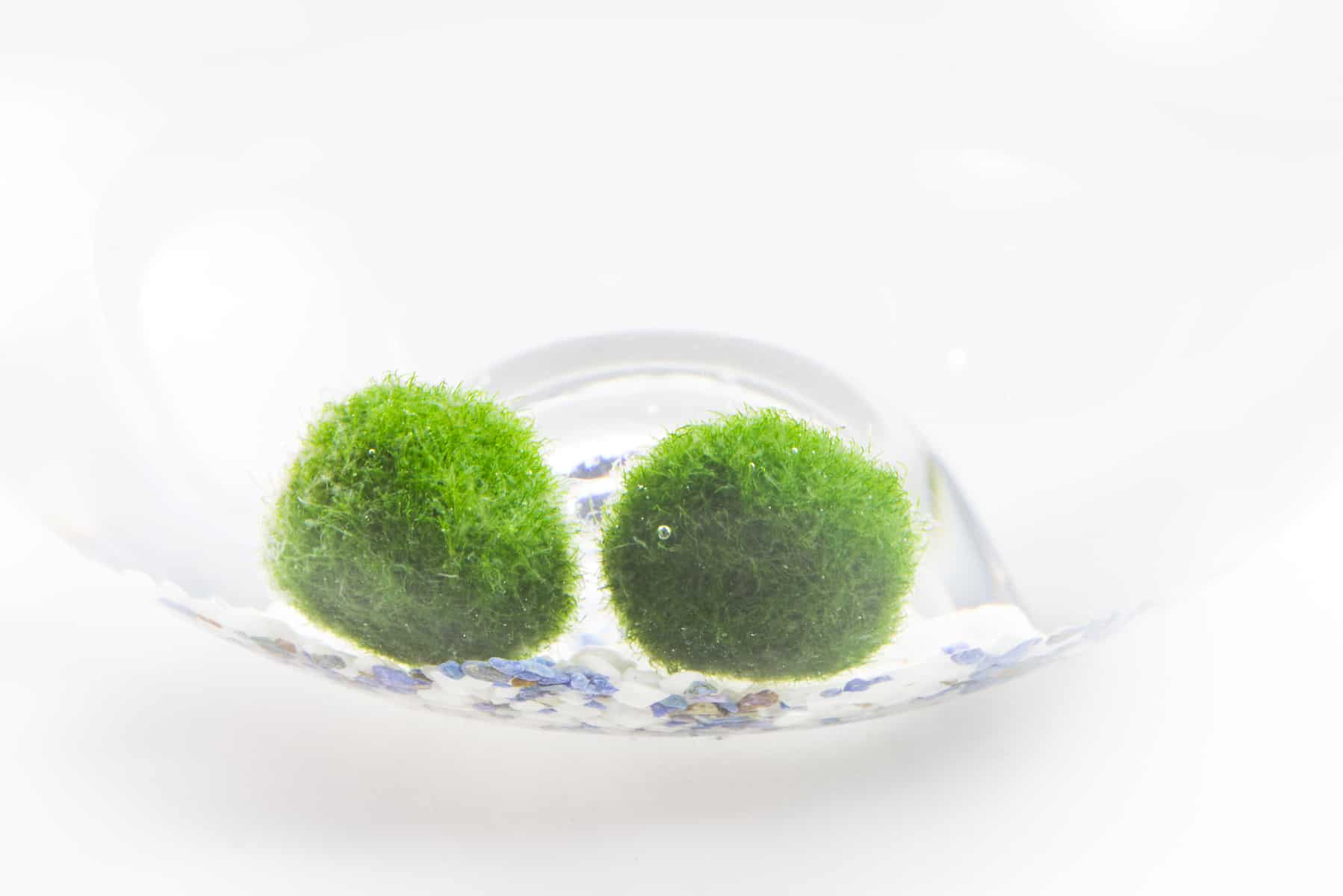When in your local fish store, you may have noticed groups of lush, green mossy balls adorning many of the display tanks. Moss balls look great in a fish tank, and they do have plenty of benefits too. But can you put betta fish with moss balls, and will your fishy friend appreciate having one of these weird organisms living in his home?
Let’s find out!
What are moss balls?
Those mysterious moss balls have many different names:
- Marimo
- Mossimo
- Seaweed ball
- Algae ball
- Japanese Moss Ball
- Lake ball
- Marimo Moss ball
The moss ball’s scientific name is Aegagropila Linnaeii. These remarkable natural structures grow slowly at a rate of only .2 inches every year, and if you buy a few of these weird green balls, you’ll get excellent value for your investment, as these things can live for over 100 years!
A small piece of trivia that you may find fun to tell your friends is that Marimo translates from the Japanese as “seaweed ball.” Although the fluffy green balls do resemble seaweed, they are actually a freshwater species that you won’t find in the ocean.
Plants or algae?
The first thing to know about these furry green spheres is that they are not a plant or a moss. Marimo moss balls are actually a form of filamentous green algae that occurs in lakes in nature, specifically in Japan, Iceland, Scotland, Australia, and Estonia. Marimo moss balls were first discovered in the 1820s, and they are now a protected species in Japan’s Lake Akan and Iceland’s Lake Myvatn. Japan has the record for the largest moss balls with some specimens in Lake Akan reaching up to 11.8 inches in diameter.
These dense balls of algae have no solid core, and remain unattached, rolling around the lake or aquarium floor at the whim of the current. This form of algae creates nutrition through photosynthesis, and they won’t turn your tank surfaces or water green like other forms of algae can.
How big do Marimo balls grow?
At their largest in the natural environment, moss balls can reach up to 12 inches in size! However, these fascinating organisms are slow to grow, gaining only around .2 inches each year.
If one ball does grow too large for a small betta tank, simply pinch the sphere into two pieces, and roll each part to create two new smaller moss balls.
So, what are the benefits of keeping Marimo moss balls in your betta’s aquarium?
Benefits of Marimo moss balls in betta tanks
Keeping Marimo moss balls in your betta tank can bring plenty of unexpected benefits.
Maintenance-free
Many hobbyists avoid keeping living plants in their betta tank, simply because of the degree of maintenance that plants require. For example, you need to have the correct lighting and water conditions, and you need to prune away overgrowth and dead leaves on a regular basis to keep the plants healthy and looking good.
However, the Marimo moss ball doesn’t need intensive maintenance. All you need to do is turn the balls occasionally, unless the water flow through the tank does that for you, and clean them, which is a quick and easy job.
Beneficial bacteria
All fish tanks need beneficial bacteria to break down the ammonia, nitrites, and nitrates that are produced by decomposing fish waste, leftover food, dead plant matter, and general aquarium detritus. Marimo moss balls provide a large surface area on which colonies of those species of beneficial bacteria can grow, helping to improve the water quality within your betta buddy’s home.
Producing oxygen and removing waste
Like all plant species, moss balls help to remove ammonia, nitrites, and nitrates from the tank, using them as a kind of nutritional fertilizer. Also, the balls remove some of the CO2 from the water, replacing it with oxygen, which is great news for your betta fish.
Reducing algae in the aquarium
Algae often grow in tanks without plants, feasting on the nutrients in the water column and using the light to photosynthesize. However, if you add a few Marimo moss balls to your tank, they will quickly use those nutrients, preventing other species of algae from growing quite so vigorously and making a mess of your tank.
No waste!
One major problem with living plants is that they create waste by shedding dead leaves. Those leaves end up on the bottom of the tank where they decay and decompose, producing ammonia and adding to the burden of your filtration system.
Marimo moss balls, on the other hand, produce no waste byproducts at all, unless they are dying, and that’s also pretty rare.
Hardy and robust
Unlike many species of aquatic plants, Marimo moss balls are extremely hardy and robust. They can tolerate an incredibly wide range of water conditions, and they can also survive in brackish water.
In fact, the only real danger to Marimo moss balls is algaecides or chlorine, which will definitely kill them.
Do bettas like Marimo moss balls?
Betta fish simply love Marimo moss balls!
Watch your pet when you first add the moss ball to his tank. The ball will float on the surface of the water until it takes on enough water to sink to the bottom. During that time, your betta will explore the ball and play with it, pushing it along the water surface. That behavior will most likely continue when the ball is on the substrate. Also, bettas love to rest on broad leaves and flat surfaces, and a fluffy, comfy Marimo moss ball makes a wonderful resting place for your pet.
Other common betta buddies, such as aquarium snails and shrimp, also love the moss ball, as the velvety textured sphere has a tendency to collect scraps of food and particles of debris on which those species feed.
How to care for Marimo moss balls
Ideally, you should keep one to three Marimo moss balls per gallon of water. That ensures that the balls will continue to grow steadily, and there will be plenty of nutrition for each one.
Unlike live plants, Marimo balls don’t need very much care. However, there are a few basics that you need to know to keep your moss balls alive and well.
Shapeshifting
Moss balls do lose their shape if they’re left in the same position for too long. Your betta may carry out that task for you by rolling the moss ball around on the substrate in his tank. In the unlikely event that your pet ignores his ball, you’ll need to do that job yourself once in a while.
Lighting
In nature, Marimo moss balls are found on the bottom of ponds and lakes where the lighting is dim, and the water is cool.
If you have a tank with low lighting, the moss balls should be fine. However, if your lights are on the bright side, you will need to provide some degree of shade for the moss balls by including some floating plants to diffuse the lighting. Exposure to excessive sunlight will cause your moss balls to turn white. Not enough lighting and the ball won’t be able to photosynthesize, so it will turn brown.
Cleaning Marimo moss balls
To keep your moss ball looking nice, you will need to clean it from time-to-time. That’s an easy job, and you don’t need to do it often. In fact, you only need to clean the moss ball when you’re carrying out routine maintenance and water changes in your betta’s tank.
Take the moss ball out of the aquarium, and put it in a bucket of old tank water. Gently squeeze the ball to remove the water from it. The ball will flatten each time you squeeze it, but when you put it back into the tank, it will absorb water and return to its round shape. Until the ball is waterlogged enough to sink, it will float on the surface, providing your betta fish with some entertainment.
If the ball does lose its shape during the cleaning process, simply roll it gently around in your hands until the spherical shape is reestablished.
Sick Marimo balls
Although Marimo balls are extremely hardy organisms, they will suffer if you don’t care for them properly. Here are some signs of a sick Marimo ball, together with some tips on how to resolve the problem.
Brown moss ball
If the moss ball turns brown, that could be due to a couple of causes.
Brownish-gray
If the moss ball turns a brownish-gray color all over, that’s simply due to a build-up of dirt, and the ball needs cleaning. See above for instructions on how to clean moss balls.
Once the ball has returned to its usual lush green color, simply pop it back into your betta fish’s tank.
One side turning brown
Although moss balls don’t like very bright lighting, they do need some light to photosynthesize. So, if your moss ball begins to turn brown on one side, it’s most likely because it isn’t getting enough light. All you need to do to fix that is simply roll the ball over and place the brown side to face the light.
Once the ball is happy and suitably illuminated, it will turn green again. Going forward, rotate the moss ball regularly so that it receives plenty of light on each side.
Moss ball turning white
If the moss ball turns white, it’s getting too much light.
You can remedy that problem easily by moving the ball to an area of the tank where it is more shaded or place some floating plants in the aquarium. As soon as the problem is resolved, the ball should revert to its usual healthy green color.
Yellowing moss ball
The algae that form the moss balls are very sensitive to certain chemicals, including chlorine and chloramine, that are found in tap water.
If the moss ball has turned yellow, usually, that’s because it has been exposed to chemicals. For example, perhaps you accidentally washed the moss ball in untreated tap water. To solve the problem, wash the moss ball in a bucket of aquarium water, and then return it to the tank. The moss should recover its usual color within a few days.
Slime
Many fish tanks develop other forms of algae that grow on the decorations, plants, and tank walls. Unfortunately, that alga also grows on moss balls, covering them in a slimy coating. It’s really important that you get rid of the alga as quickly as possible, or your moss ball will be starved of nutrition, ultimately suffocating and dying.
Remove the moss ball from the tank and carefully pick off the slimy coating. You can also shift algae by gently rubbing the coating until it all comes off.
Marimo moss balls disintegrating
Sometimes, moss balls begin to fall apart. Don’t panic! All you need to do is gather up the pieces of the balls and roll them into small spheres. Make sure that the balls are getting plenty of light and are being rotated regularly, and you should finish up with a whole new Marimo moss ball family for your betta tank!
Blackened Marimo moss ball
If your Marimo moss ball turns black, that’s a potential catastrophe, as the black areas are those that are dying.
However, you can possibly save the moss ball by picking out all the black bits and washing the moss ball in some old tank water. Make sure that you reform the moss ball by squeezing and rolling it so that it doesn’t fall apart.
Marimo ball not sinking
Because moss balls do not have a solid core, you may find that yours floats to the water surface after it’s been cleaned. That’s simply because the ball contains small pockets of air. So, to fix the problem, all you need to do is squeeze the moss ball gently underwater to get rid of the air, and it will sink again.
Propagating Marimo moss balls
In nature, moss balls reproduce by shedding small lumps that go on to become new organisms. However, because moss balls grow very slowly and take many years to get to a size where natural reproduction is possible, you may want to give nature a helping hand and propagate them yourself.
Provided that you have a large enough moss ball, you can do that by squeezing all the water out of the sphere and then splitting it in half or into quarters if the original ball is big enough. Carefully roll the new ball in your hand to get the correct shape, and then put it into your betta tank.
Availability
Marimo moss balls are widely available from most good fish stores and even online. When buying moss balls in a store, always check to see that the fishes in the display tank with the balls are in good health and that the moss ball is a nice green color.
When buying online, double-check to see that the product you’re ordering is a real moss ball and not a fake. Although fakes will still look good in your betta fish tank and will provide your pet with a toy and somewhere to rest, they don’t bring any of the other benefits that we described earlier in this guide.
Generally, the larger the Marimo, the more expensive they are. However, you should only expect to pay a few dollars for a single ball, and you can very often buy them in groups of different sized specimens, which represents the best deal.
Final thoughts
If you’re looking for an attractive decoration for your betta fish tank that provides your fishy friend with somewhere to rest, a toy to provide him with entertainment, and a living organism that will help to keep your pet’s environment healthy, you might want to consider adding a couple of Marimo moss balls to your setup.
Marimo moss balls are super-easy to care for, look great, and can live for over 100 years. What’s not to like?












